
© Copyright 2015 - FX Hometrader - All rights reserved.

Swing Trading Strategy
A Swing trade is a trading strategy that attempts to capture gains in the market within a 1 to 4 day period. Swing traders use technical analysis to identify currency moves with short term price momentum rather than focus on the fundamental or intrinsic value of the currency pair. Swing traders are more focused on price trends and patterns.Identify the Trend
The first step is to identify the trend. Trends typically move in 5 wave patterns with a 3 wave retracement and then a new 5 wave trend until the pattern is broken. The following EUR/USD 1 hour chart shows a typical wave pattern. If we examine the above chart we can see that the left of the chart the market was in a down trend. In a typical wave pattern formation, the retracement of each leg should be at least 38.2% of the previous price swing. The 3rd wave of any pattern is typically the largest wave and once the 5 wave pattern is complete then we have a 3 wave retracement pattern. If we dissect the above chart then we can see that after the down move we had wave 1 which retraced to the Fibonacci 61.8 % retracement area to form wave 2. As is typical wave 3 was the largest wave and only retraced to the Fibonacci 38.2% retracement area to form wave 4.Wave 5 stopped at about the 127% Fibonacci extension signalling the end of the trend. Wave “A” the retracement wave dropped below the Fib 78.6 % of wave 5 then retraced to the 61.8% fib level of wave “A” to form wave “B.” Wave “C” only dropped to the 138.2 % fib extension signalling the end of the down trend prior to forming the new wave 1. Wave 2 formed when wave 1 retraced to the 61.8 percent of the wave 1 swing. Wave 3 is the current wave and is typically larger than wave 1 and looks to continue up. Now that we have identified how the wave pattern works we need to identify our entry points. Typically we cannot enter at the start of wave 1 as we need to be patient to confirm the formation of a new trend pattern. There are 2 possible entries to this swing trade; the first is the 61.8% retracement of wave 1 that forms wave 2. This would have been the best possible entry with the tightest stop possible. This would have given us an entry at about 1.3048 with a stop loss at about 1.300 for a 48 pip stop loss. This trade peaked precisely at the fib 1.618 target extension. The second potential entry for the less aggressive traders could have been at the confirmed break of the high of wave 1 with a stop loss placed below the 61.8 % retracement of wave 2. The idea of a swing trade though is to benefit from the full 5 wave pattern. On the above chart the entry point and first fib has been added which yielded a 140 pip profit to that point. On the following chart we can see that the retracement from the first 1.618 fib extn. did not retrace to the 38.2 retracement area signalling that wave 3 still had further to run. Here could have placed our profit target at the new 1.618 Fib profit extn. At 1.3277. The wave pattern eventually ended at the new 1.618 profit target yielding 233 pips for the trade over a 5 day period. On the following chart we can examine a short trade with a typical 5 wave pattern. On this chart we have the same entry criteria using the 61.8 retracement of the wave 1 swing 1.3257and stop loss at 1.3320 about a 65 pip stop. Once again we aim for at least 1 1.5 to 2 to 1 risk reward ratio. By staying with the trade till the 5 wave pattern completed we could have exited the trade at the Fib 200 % 1.2992 for 266 pips over a 3 day period. Whilst there are many swing trading methods using other indicators this method relies on the basic Elliot Wave trading pattern. These patterns repeat themselves time and again. Any profitable trading system relies on consistency and good money management principals.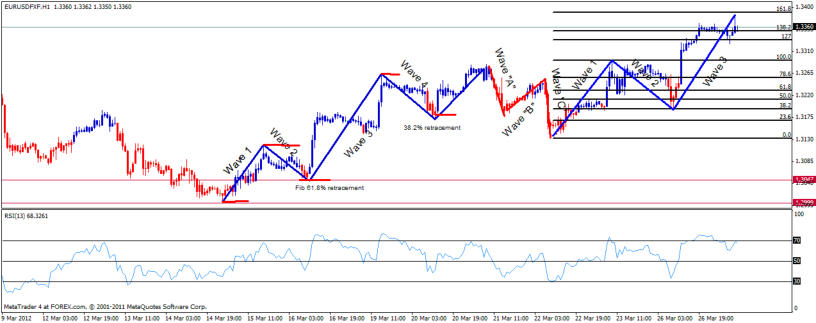
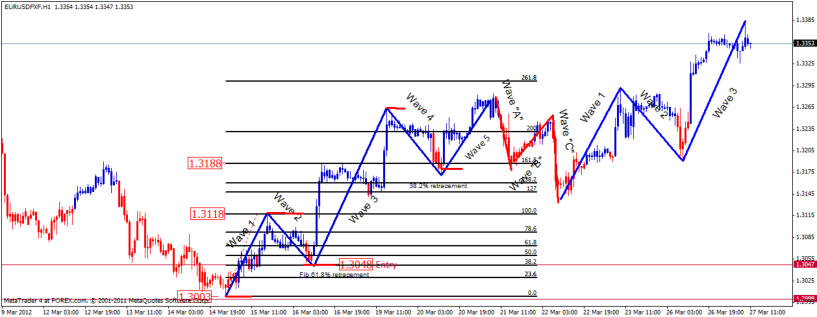



- Forex Trading Chart Patterns
- Price Actions Charts
- Fibonacci Trading
- Fibonacchi Levels Tutorials
- Trading with the Elliott Wave
- Trading with Bollinger Bands
- Trading with the MACD
- Candlestick Trading Tutorial
- Pivot Points Trading
- Trading with the RSI Indicator
- Trading with the Stochastic Indicator
- Swing Trading Strategy
- Support and Resistance Levels
- Stop Loss Tutorial

© Copyright 2016 - FX Hometrader - All rights reserved.

Swing Trading Strategy
A Swing trade is a trading strategy that attempts to capture gains in the market within a 1 to 4 day period. Swing traders use technical analysis to identify currency moves with short term price momentum rather than focus on the fundamental or intrinsic value of the currency pair. Swing traders are more focused on price trends and patterns.Identify the Trend
The first step is to identify the trend. Trends typically move in 5 wave patterns with a 3 wave retracement and then a new 5 wave trend until the pattern is broken. The following EUR/USD 1 hour chart shows a typical wave pattern. If we examine the above chart we can see that the left of the chart the market was in a down trend. In a typical wave pattern formation, the retracement of each leg should be at least 38.2% of the previous price swing. The 3rd wave of any pattern is typically the largest wave and once the 5 wave pattern is complete then we have a 3 wave retracement pattern. If we dissect the above chart then we can see that after the down move we had wave 1 which retraced to the Fibonacci 61.8 % retracement area to form wave 2. As is typical wave 3 was the largest wave and only retraced to the Fibonacci 38.2% retracement area to form wave 4.Wave 5 stopped at about the 127% Fibonacci extension signalling the end of the trend. Wave “A” the retracement wave dropped below the Fib 78.6 % of wave 5 then retraced to the 61.8% fib level of wave “A” to form wave “B.” Wave “C” only dropped to the 138.2 % fib extension signalling the end of the down trend prior to forming the new wave 1. Wave 2 formed when wave 1 retraced to the 61.8 percent of the wave 1 swing. Wave 3 is the current wave and is typically larger than wave 1 and looks to continue up. Now that we have identified how the wave pattern works we need to identify our entry points. Typically we cannot enter at the start of wave 1 as we need to be patient to confirm the formation of a new trend pattern. There are 2 possible entries to this swing trade; the first is the 61.8% retracement of wave 1 that forms wave 2. This would have been the best possible entry with the tightest stop possible. This would have given us an entry at about 1.3048 with a stop loss at about 1.300 for a 48 pip stop loss. This trade peaked precisely at the fib 1.618 target extension. The second potential entry for the less aggressive traders could have been at the confirmed break of the high of wave 1 with a stop loss placed below the 61.8 % retracement of wave 2. The idea of a swing trade though is to benefit from the full 5 wave pattern. On the above chart the entry point and first fib has been added which yielded a 140 pip profit to that point. On the following chart we can see that the retracement from the first 1.618 fib extn. did not retrace to the 38.2 retracement area signalling that wave 3 still had further to run. Here could have placed our profit target at the new 1.618 Fib profit extn. At 1.3277. The wave pattern eventually ended at the new 1.618 profit target yielding 233 pips for the trade over a 5 day period. On the following chart we can examine a short trade with a typical 5 wave pattern. On this chart we have the same entry criteria using the 61.8 retracement of the wave 1 swing 1.3257and stop loss at 1.3320 about a 65 pip stop. Once again we aim for at least 1 1.5 to 2 to 1 risk reward ratio. By staying with the trade till the 5 wave pattern completed we could have exited the trade at the Fib 200 % 1.2992 for 266 pips over a 3 day period. Whilst there are many swing trading methods using other indicators this method relies on the basic Elliot Wave trading pattern. These patterns repeat themselves time and again. Any profitable trading system relies on consistency and good money management principals.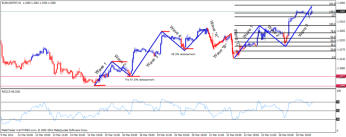
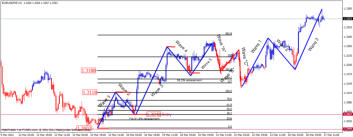
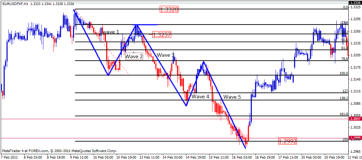


- Home
- Introduction to Forex Trading
- Trading Requirements
- Forex Trading Times
- How to Choose Your Broker
- Brokerage Firms
- About Managed Accounts
- Technical Analysis Tutorials
- Forex Trading Tutorials
- Price Action Charts
- Fibonacci Trading
- Fibonacci Levels Tutorial
- Trading with the Elliott Wave
- Trading with Bollinger Bands
- Trading with MACD
- Candlestick Trading Tutorial
- Pivot Points Trading Tutorial
- Pivot Point Calculator
- Trading with the RSI Indicator
- Trading with the Stochastic Indicator
- Swing Trading Strategy
- Stop-Loss Tutorial
- Free Trading Magazines
- Free Trading Software
- Forex Trading Books
- Forex Trading Articles
- Glossary
- About Us
- Contact Us











